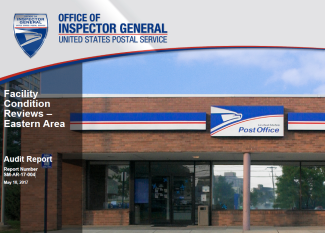Facility Condition Reviews – Eastern Area
Background
The U.S. Postal Service has more than 30,000 leased and owned retail facilities nationwide. Over 5,800 of these facilities are in the Eastern Area. The Post Office lobby is the principal business office of the Postal Service. The lobby’s appearance directly affects the Postal Service’s image because it is the only close-up view of postal operations for many customers. The Postal Service must maintain a safe environment for employees and customers and follow safety laws set forth by the Occupational Safety and Health Administration (OSHA).
Our objective was to determine if Postal Service management adhered to building maintenance, safety and security standards, and employee working condition requirements at retail facilities. We reviewed 51 facilities in the Eastern Area and assessed items related to building safety, security, maintenance, customer complaints, workplace environment, and workplace violence. We also assessed whether each facility was handicap accessible.
This is the fifth in a series of audits assessing retail facility conditions nationwide.
What the OIG Found
The Postal Service must improve adherence to building maintenance, safety and security standards, and employee working condition requirements at its retail facilities. We reviewed 51 facilities and found:
■ Thirty-two facilities (63 percent) had building safety and security issues;
■ Thirty-two facilities (63 percent) had potential OSHA violations;
■ Twenty-five facilities (49 percent) had cleanliness and maintenance issues;
■ Thirty-five (69 percent) did not maintain a customer complaint log or monitor how promptly complaints are resolved;
■ Forty-four facilities (86 percent) did not display workplace environment posters such as those that inform employees what to do when injured at work;
■ Twenty-four facilities (47 percent) did not display workplace violence posters, such as Zero Tolerance Policy and Reporting Procedures; and,
■ Five facilities (10 percent) did not provide handicap accessibility or handicap areas needed maintenance or repairs.
Issues related to building safety, security, and maintenance occurred because of competing priorities and local management’s failure to focus on cleaning and general maintenance and repairs, and housekeeping inspections. In addition, management did not provide sufficient oversight of, communicate with, or train employees effectively regarding requirements for reporting deficiencies, completing inspections and facility maintenance, the need to maintain a customer complaint log, or the need to display required posters.
Attention to these areas could improve employee morale and reduce employee turnover. It could also reduce the risk of injuries to customers and employees and related costs, such as workers’ compensation claims, loss of work and productivity, lawsuits, and OSHA fines and penalties. Poorly maintained and unappealing lobbies can also reduce brand loyalty, which impacts revenue.
Local management took corrective action by immediately addressing certain deficiencies brought to their attention during our site visits, such as displaying many missing posters and unblocking exits.
What the OIG Recommended
We recommended management develop and implement an action plan to address all building safety, security, maintenance, workplace environment, workplace violence policy, and handicap accessibility issues identified during our audit; direct retail facilities personnel to timely input all applicable safety, security, and maintenance issues into the electronic Facilities Management System; establish an oversight mechanism to ensure compliance with recording, tracking and the timely resolution of customer complaints; and reiterate the requirements to perform housekeeping inspections.
We also recommended management establish an oversight mechanism to ensure adherence to policies and procedures relating to maintenance standards, fire extinguisher maintenance, facility and vehicle safety, and poster display; reinforce safety inspection policies and procedures, provide training, and establish an oversight mechanism to ensure safety inspections are completed accurately and deficiencies are addressed.

